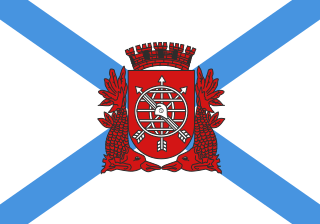
The Tijuca Forest is a tropical rainforest in the city of Rio de Janeiro, Brazil. It is claimed to be the world's largest urban forest, covering some 32 km² (12.4 mi²), although there are sources assigning this title to the urban forest of Johannesburg, South Africa, where between 6 and 9.5 million trees were planted. Similar to Rio de Janeiro's Tijuca Forest, the UNESCO World Heritage Site Singapore Botanic Gardens is another renowned garden with a tropical rainforest within its city limits.

Ilha Comprida is a municipality in the state of São Paulo in Brazil. Stretching southwest along the Atlantic coast of the state, it is coextensive with the barrier island of Ilha Comprida, the longest of its kind in the state. The municipality was founded in 1993 after the merger of the part of Ilha Comprida that belonged to the city of Cananéia with the section of the island that was administered by the city of Iguape.

The Ilhéus do Rombo, also known as the Ilhéus Secos, are a group of small, uninhabited islands in the Cape Verde archipelago, lying 600 km off the coast of north-west Africa in the Atlantic Ocean. The islets form an integral nature reserve. They are sited on a volcanic seamount 7 km north of Brava and 15 km west of Fogo. The two major islets of the chain are Ilhéu Grande (300 ha) and Ilhéu de Cima (150 ha). Administratively they are part of the municipality of Brava. They can be seen from Brava and, sometimes, from Fogo.

Silva Jardim is a municipality located in the Brazilian state of Rio de Janeiro. Its population was 21,349 (2010) and its area is 938 km².

Tamoios Ecological Station is a coastal marine ecological station in the state of Rio de Janeiro, Brazil.

Cananéia-Iguape-Peruíbe Environmental Protection Area is a protected area in the State of São Paulo, Brazil.

Praia do Sul State Biological Reserve is a biological reserve on the island of Ilha Grande, in the State of Rio de Janeiro, in Brazil.

Guaratiba Biological and Archeological Reserve is a State biological reserve located in the western zone of Rio de Janeiro city, in the State of Rio de Janeiro, Brazil. It protects an important area of mangroves and wetlands in the east of Guaratiba bay.

The Cabras Islet is a dual islet, along the southern coast of the island of Terceira in the Portuguese archipelago of the Azores. The group, with a total area of 29 hectares and perimeter of 3,239 metres (10,627 ft), is the largest islet in the Azores, normally referred to as a single islet by locals, but comprising two landforms: the Ilhéu Pequeno and the Ilhéu Grande.

The Nature Park of Santa Maria, or simply or Santa Maria Nature Park (PNSM) developed from the intention of better managing the protected areas of the island of Santa Maria, and was instituted by the Secretaria Regional do Ambiente e do Mar, of the Autonomous Regional Government of the Azores. Several natural landscapes were preserved and their use conditioned in order to foster conservation and support endemic flora and fauna species, as well as provide communal forms of recreation and nature interpretation.

The Marapendi Natural Municipal Park is a municipal nature park, a public recreation facility of approximately 155 hectares within the Marapendi Natural Reserve, located in the Barra da Tijuca and Recreio neighborhoods of Rio de Janeiro, Brazil and part of a protected area for the preservation of native plants and animals.

The Ilhas dos Currais Marine National Park is a national park in the state of Paraná, Brazil. It protects an important nesting site for birds, and is a refuge and feeding ground for fish including two endangered species of grouper. It may be visited for diving, but visitors must be careful to avoid any impact on the environment.

The Ilhas do Abrigo e Guararitama Wildlife Refuge (Portuguese: Refúgio de Vida Silvestre das Ilhas do Abrigo e Guararitama is a wildlife refuge off the south coast of the state of São Paulo Brazil.

The Aventureiro Sustainable Development Reserve, formerly the Aventureiro Marine State Park, is a sustainable development reserve in the state of Rio de Janeiro, Brazil. It supports artisanal fishing by a small traditional community on the Ilha Grande, an island off the southwest coast of the state.

The Tamoios Environmental Protection Area is an environmental protection area of the state of Rio de Janeiro, Brazil. It protects an area of coastal forests, mangroves, rocky shores and islands.

The Sugarloaf Mountain and Urca Hill Natural Monument is a natural monument in the city of Rio de Janeiro, Brazil. It protects the Sugarloaf Mountain and the adjoining Morro da Urca, distinctive landmarks of the city.

The Mendanha State Park (Portuguese: Parque Estadual do Mendanha is a state park in the state of Rio de Janeiro, Brazil.

The following outline is provided as an overview of and topical guide to Rio de Janeiro:


























